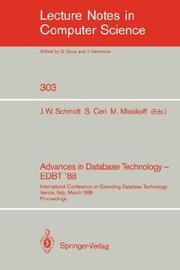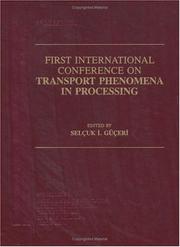| Listing 1 - 5 of 5 |
Sort by
|

ISBN: 3540190740 0387190740 9783540190745 Year: 1988 Volume: 303 Publisher: Berlin Springer
Abstract | Keywords | Export | Availability | Bookmark
 Loading...
Loading...Choose an application
- Reference Manager
- EndNote
- RefWorks (Direct export to RefWorks)
Information systems --- Organization theory --- Database management --- Bases de données --- Congresses --- Gestion --- 681.3*H2 --- 681.3*D33 --- 681.3*E2 --- 681.3*F4 --- 681.3*I2 --- Database management: security; integrity; protection--See also {?681.5*E5} --- Languages constructs: abstract data types; concurrent programming structures;control structures; coroutines (Programming languages) --- Data storage representations: composite structures; contiguous representations; hash-table representations; linked representations; primitive data items --- Mathematical logic and formal languages (Theory of computation) --- Artificial intelligence. AI --- 681.3*I2 Artificial intelligence. AI --- 681.3*F4 Mathematical logic and formal languages (Theory of computation) --- 681.3*E2 Data storage representations: composite structures; contiguous representations; hash-table representations; linked representations; primitive data items --- 681.3*D33 Languages constructs: abstract data types; concurrent programming structures;control structures; coroutines (Programming languages) --- 681.3*H2 Database management: security; integrity; protection--See also {?681.5*E5} --- Gestion. --- Data Base --- Lncs --- Bases de données

ISBN: 1566760054 Year: 1993 Publisher: Lancaster, Pa. : Technomic Pub. Co.,
Abstract | Keywords | Export | Availability | Bookmark
 Loading...
Loading...Choose an application
- Reference Manager
- EndNote
- RefWorks (Direct export to RefWorks)
Heat --- Manufacturing processes --- Mass tranfer --- Chaleur --- Fabrication --- Transmission --- Congresses --- Congrès --- Mass transfer --- Congresses. --- Congrès
Book
ISBN: 1402084404 1402084382 9786611860622 128186062X 1402084390 Year: 2008 Publisher: Dordrecht, Netherlands : Springer,
Abstract | Keywords | Export | Availability | Bookmark
 Loading...
Loading...Choose an application
- Reference Manager
- EndNote
- RefWorks (Direct export to RefWorks)
Plasma decontamination is a rapidly expanding area of modern science and engineering. An increasing number of engineers are using plasma methods for decontamination of chemical and biological agents. Plasma decontamination is effectively applied today to clean and sterilize different surfaces, high volume air and water streams, industrial exhausts, and even living tissue of animals and humans. This book provides a fundamental introduction to virtually all aspects of modern plasma decontamination, as well as the most recent technological achievements in the area. The book is segmented into four specific sections of modern plasma decontamination: (1) plasma bio-decontamination, including disinfection and sterilization of surfaces, water and air streams; (2) plasma decontamination of chemical agents, including cleaning of air, water, and industrial exhaust gases from different pollutants and especially volatile organic compounds VOC; (3) plasma treatment of living tissue, including different subjects of plasma medicine from skin sterilization to tissue engineering; (4) major electric discharges applied for the plasma-assisted decontamination of chemical and biological agents.
Environment. --- Engineering. --- Environmental sciences. --- Air pollution. --- Atmospheric Protection/Air Quality Control/Air Pollution. --- Engineering, general. --- Environmental Physics. --- Air --- Air contaminants --- Air pollutants --- Air pollution --- Air pollution control --- Air toxics --- Airborne pollutants --- Atmosphere --- Contaminants, Air --- Control of air pollution --- Pollutants, Air --- Toxics, Air --- Pollution --- Air quality --- Atmospheric deposition --- Environmental science --- Science --- Construction --- Industrial arts --- Technology --- Control --- Environmental protection. --- Physical geography. --- Geography --- Environmental quality management --- Protection of environment --- Environmental sciences --- Applied ecology --- Environmental engineering --- Environmental policy --- Environmental quality --- Biological decontamination --- Plasma products --- Decontamination --- Products, Plasma --- Blood plasma --- Blood products --- Biological agents decontamination --- Biological materials decontamination --- Decontamination from biological agents --- Decontamination of biological agents --- Infectious agents decontamination --- Microbiological agents decontamination --- Disinfection and disinfectants --- Microbial contamination
Digital

ISBN: 9783540764526 Year: 2008 Publisher: Berlin, Heidelberg Springer-Verlag Berlin Heidelberg
Abstract | Keywords | Export | Availability | Bookmark
 Loading...
Loading...Choose an application
- Reference Manager
- EndNote
- RefWorks (Direct export to RefWorks)
Book

ISBN: 9783540764526 Year: 2008 Publisher: Berlin, Heidelberg Springer-Verlag Berlin Heidelberg
Abstract | Keywords | Export | Availability | Bookmark
 Loading...
Loading...Choose an application
- Reference Manager
- EndNote
- RefWorks (Direct export to RefWorks)
The Semantic Web is a vision - the idea of having data on the Web defined and linked in such a way that it can be used by machines not just for display purposes but for automation, integration and reuse of data across various applications. Technically, however, there is a widespread misconception that the Semantic Web is primarily a rehash of existing AI and database work focused on encoding knowledge representation formalisms in markup languages such as RDF(S), DAML+OIL or OWL. Kashyap, Bussler, and Moran seek to dispel this notion by presenting the broad dimensions of this emerging Semantic Web and the multi-disciplinary technological underpinnings like machine learning, information retrieval, service-oriented architectures, and grid computing, thus combining the informational and computational aspects needed to realize the full potential of the Semantic Web vision. Throughout the book, the use-case of a clinical vignette will serve to motivate and explain solutions based on Semantic Web technologies, emphasizing the application aspects related to data integration, knowledge acquisition, change management, semantic web services, and workflow management. With this textbook, the authors deliver an application-driven state-of-the-art presentation of Semantic Web technologies, ideally suited for academic courses on the Semantic Web and architectures of information systems, and for self-studying professionals engaged in the design and implementation of advanced application systems.
| Listing 1 - 5 of 5 |
Sort by
|

 Search
Search Feedback
Feedback About UniCat
About UniCat  Help
Help News
News